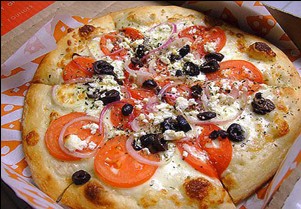We all have eaten Pizzas. It’s one of the most enjoyed dishes across the world. But do you know how Pizza was invented and how it managed to win hearts all over? You will be surprised to know that Pizza was actually transformed from the patties made of mashed grains. The Pizza has gone through centuries of evolution, most significant of which is the change in the primary ingredient, from various coarse grains to solely wheat-based dough, and eventually to a dish made almost exclusively with white flour
And along with the many forms pizza has taken, its composition, toppings, seasonings, methods of preparation, and the equipment used too have altered radically over the years.
Derivation of the Term “Pizza”
The word “pizza” simply means “pie”. It is a Southern Italian derivative of the Roman term picea, both a bread itself and the ash-blackened underside of the Roman bread called placenta. Some say this term eventually evolved into “piza,” then “pizza.” Similarly, another flat bread, pitta, thought by some to have been introduced to southern Italy during the sixth-century Byzantine conquest, may also have influenced the modern day pronunciation of “pizza.”
The Invention of Pizza
Every Pizza fan knows Pizza came from Italy. For millennia, pizza, a food of various origins and multiple styles, played an important role in the diet of those who inhabited Italy. Neolithic nomads, the Etruscans from the North, and the Greeks from southern regions were the three earliest societies to develop pizza prototypes, like for example, focaccia. Each group made small adaptations that changed the original product into a slightly more refined dish. As early as the Stone Age, Neolithic hunter-gatherer tribal groups foraged throughout what would become Italy for wild grains, among them wheat varieties such as emmer and einkorn, as well as barley. These were commonly first soaked or boiled, and the grains were mashed into pastes and cooked on hot stones over open fires.
Later, around 1000 B.C.E., the Etruscans, a people of uncertain origin, introduced their flatbread to Northern Italy. Like the Neolithic tribes before them, the Etruscans pounded their grains. However, unlike their predecessors, the Etruscans baked their mash on stones and buried the stones in the ashes, creating smoky tasting bread. They further elaborated on the primitive Neolithic flatbread by seasoning the mash with oil and herbs after baking it.
The Greeks possessed superior baking skills and technology and so they further advanced on pizza during their 600-year (730–130 B.C.E.) occupation of the southern areas of the Italian peninsula. Like their predecessors, they produced a grain-based mash, but instead of placing the toppings on the cooked breads, they placed them on the raw dough prior to baking. This was to ensure a more highly flavoured dish. For example, Plakuntos, which were basically round bread made with various simple toppings- among them oil, garlic, onion, and herbs. Additional Greek contributions included the use of ovens, instead of open fires, and the development of kneading, which produced more digestible bread.
Soon the Romans combined the Etruscan and Greek techniques to create the pizza antecedent most like the pizza known today. They valued the intense heat the Etruscans achieved by baking their flatbreads below the fire, and they appreciated the Greek idea of preseasoning the dough. If the Greeks and Etruscans were primarily responsible for creating the prototypes of what was to become pizza, and the ancient Romans were responsible for improving it, it was largely the Neapolitans who brought it fame. Probably not coincidentally, the Neapolitans were responsible for the addition of the ingredient most commonly associated with pizza today—the tomato.
There’s an interesting part attached to the tomatoes role in pizza. One argues that it was because tomatoes were believed to be poisonous, another that the earliest tomatoes were inferior and, therefore, eaten only in modest amounts until quality improved enough to make the fruit genuinely popular. In the area of Naples, for example, a key moment appears to have come in the middle of the eighteenth century with the development of a pleasing, large, and sweet tomato. The fruit quickly became the mainstay of Neapolitan pizza toppings.
Becoming everyone’s favorite
Things changed a lot in the year 1889. It was then that inspiration is said to have struck Raffaele Esposito, a noted Neapolitan pizzaiolo (pizza chef), who decided to pay homage to Queen Margherita and King Umberto I of Savoia, the ruling house of Italy, by adding mozzarella to the traditional tomato and basil pie. The combination of red, white, and green suggested the colours of the Italian flag and saluted the United Kingdom of Italy, a gesture that for patriotic reasons is said to have made the pie a favourite of the queen.
Even though most stories of origin give Esposito credit for adding cheese and thereby inventing the tri-colour pizza, still known as Pizza Margherita, others deny it, believing that mozzarella had been used earlier. There is no doubt, however, that Esposito popularized the “made for each other” combination of cheese, dough, and tomato that produced a dish even more delicious than before, thereby setting the modest pie on a course to fame that he could never have imagined.
Rise to popularity
Pizza was rarely prepared at home because few people had the skill to stretch the dough properly or the money to build a wood-fired oven in which to bake it. So it was almost always bought from small stalls or from pizza sellers carrying their aromatic wares through the crowded Neapolitan streets. Some more elaborate open-air pizza stands offered slightly more upscale options, along with makeshift seating, but it was not until 1830 that the first documented pizzeria, that is, an inexpensive gathering place specializing in pizza and equipped with wood burning stoves, began doing business in Naples. It was called Port’Alba. Still in operation, its opening marked the birth of a style of eating establishment now known around the world.
Pizza’s popularity rose rapidly and it gained acceptability worldwide. It’s still one of the world’s simplest yet most popular foods.








Leave a Reply
You must be logged in to post a comment.